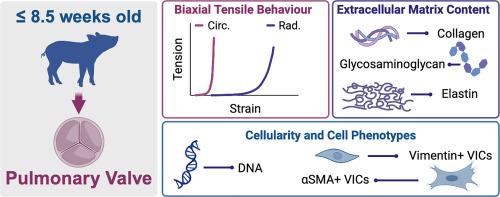Characterization of pediatric porcine pulmonary valves as a model for tissue engineered heart valves
IF 9.4
1区 医学
Q1 ENGINEERING, BIOMEDICAL
引用次数: 0
Abstract
Heart valve tissue engineering holds the potential to transform the surgical management of congenital heart defects affecting the pediatric pulmonary valve (PV) by offering a viable valve replacement. While aiming to recapitulate the native valve, the minimum requirement for tissue engineered heart valves (TEHVs) has historically been adequate mechanical function at implantation. However, long-term in situ functionality of TEHVs remains elusive, suggesting that a closer approximation of the native valve is required. The realization of biomimetic engineered pediatric PV is impeded by insufficient characterization of healthy pediatric tissue. In this study, we comprehensively characterized the planar biaxial tensile behaviour, extracellular matrix (ECM) composition and organization, and valvular interstitial cell (VIC) phenotypes of PVs from piglets to provide benchmarks for TEHVs. The piglet PV possessed an anisotropic and non-linear tension-strain profile from which material constants for a predictive constitutive model were derived. The ECM of the piglet PV possessed a trilayer organization populated by collagen, glycosaminoglycans, and elastin. Biochemical quantification of ECM content normalized to wet weight and DNA content of PV tissue revealed homogeneous distribution across sampled regions of the leaflet. Finally, VICs in the piglet PV were primarily quiescent vimentin-expressing fibroblasts, with a small proportion of activated α-smooth muscle actin-expressing myofibroblasts. Overall, piglet PV properties were consistent with those reported anecdotally for pediatric human PVs and distinct from those of adult porcine and human PVs, supporting the utility of the properties determined here to inform the design of tissue engineered pediatric PVs.
Statement of significance
Heart valve tissue engineering has the potential to transform treatment for children born with defective pulmonary valves by providing living replacement tissue that can grow with the child. The design of tissue engineered heart valves is best informed by native valve properties, but native pediatric pulmonary valves have not been fully described to date. Here, we provide comprehensive characterization of the planar biaxial tensile behaviour, extracellular matrix composition and organization, and valvular interstitial cell phenotypes of pulmonary valves from piglets as a model for the native human pediatric valve. Together, these findings provide standards that inform engineered heart valve design towards generation of biomimetic pediatric pulmonary valves.

作为组织工程心脏瓣膜模型的小儿猪肺动脉瓣的特征。
心脏瓣膜组织工程通过提供一种可行的瓣膜替代物,有望改变影响小儿肺动脉瓣(PV)的先天性心脏缺陷的外科治疗。组织工程心脏瓣膜(TEHVs)的目标是再现原生瓣膜,其最低要求历来是在植入时具有足够的机械功能。然而,组织工程心脏瓣膜的长期原位功能仍难以实现,这表明需要更接近原生瓣膜。健康儿科组织的特征描述不足阻碍了生物仿生工程儿科瓣膜的实现。在这项研究中,我们全面描述了小猪瓣膜的平面双轴拉伸行为、细胞外基质(ECM)的组成和组织以及瓣膜间质细胞(VIC)的表型,为 TEHV 提供了基准。仔猪瓣膜具有各向异性和非线性的张力-应变曲线,据此可推导出预测构成模型的材料常数。仔猪腹膜的 ECM 具有三层组织,由胶原蛋白、糖胺聚糖和弹性蛋白组成。根据湿重和 PV 组织 DNA 含量对 ECM 含量进行归一化的生化定量分析显示,ECM 在小叶取样区域内分布均匀。最后,仔猪肺泡中的 VIC 主要是表达波形蛋白的静止成纤维细胞,还有一小部分活化的表达α-平滑肌肌动蛋白的肌成纤维细胞。总体而言,仔猪肺泡的特性与坊间报道的小儿人类肺泡的特性一致,而与成年猪和人类肺泡的特性不同,这支持了本文所确定的特性在设计组织工程小儿肺泡时的实用性。意义声明:心脏瓣膜组织工程有可能改变先天性肺动脉瓣缺损儿童的治疗方法,因为它能提供可与儿童一起生长的活体替代组织。组织工程心脏瓣膜的设计最好参考原生瓣膜的特性,但迄今为止对原生小儿肺动脉瓣的描述并不全面。在这里,我们对作为原生人类小儿瓣膜模型的仔猪肺动脉瓣的平面双轴拉伸行为、细胞外基质组成和组织以及瓣膜间质细胞表型进行了全面描述。这些研究结果为工程心脏瓣膜的设计提供了标准,有助于生成生物仿生小儿肺动脉瓣。
本文章由计算机程序翻译,如有差异,请以英文原文为准。
求助全文
约1分钟内获得全文
求助全文
来源期刊

Acta Biomaterialia
工程技术-材料科学:生物材料
CiteScore
16.80
自引率
3.10%
发文量
776
审稿时长
30 days
期刊介绍:
Acta Biomaterialia is a monthly peer-reviewed scientific journal published by Elsevier. The journal was established in January 2005. The editor-in-chief is W.R. Wagner (University of Pittsburgh). The journal covers research in biomaterials science, including the interrelationship of biomaterial structure and function from macroscale to nanoscale. Topical coverage includes biomedical and biocompatible materials.
 求助内容:
求助内容: 应助结果提醒方式:
应助结果提醒方式:


